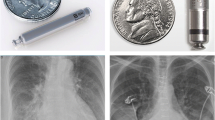Abstract
Purpose
Optimal atrial pacemaker lead position and fixation mechanism have not been determined with regard to effect on complications. We aimed to determine the association between atrial lead-related complications and varying atrial lead tip positions and lead fixation mechanisms.
Methods
All patients who underwent dual-chamber pacemaker implant between 2004 and 2014 were retrospectively reviewed for atrial lead tip position and fixation type. Lead-related complications were assessed by electronic medical record review. Complication rates were compared at 1 year by chi-square analysis and at 5 years using a Kaplan-Meier analysis.
Results
During the study period, 3451 patients (mean age 73.9, 53.4 % male) underwent dual-chamber pacemaker placement. Active fixation leads were associated with a higher incidence of pericardial effusion (81 (2.9 %) vs. 6 (1.0 %), p = 0.005) and pericardiocentesis (46 (1.6 %) vs. 2 (0.3 %), p = 0.01) at 1 year compared to passive fixation leads. There was no difference in overall complication rates by fixation type (161 (5.7 %) vs. 29 (4.6 %), p = 0.26). Low atrial septal lead tip position was associated with a higher rate of lead dislodgement (10 (15.2 %)) compared to appendage (46 (1.6 %)), free wall (10 (2.1 %)), or high atrial septal (2 (4.7 %)) positions (p < 0.001). This difference was also reflected in a significantly increased need for lead revision and overall complications. A multivariate analysis which included potential confounders confirmed the association of active fixation leads with an increased rate of perforation-related complications (p = 0.03) and septal lead location with increased rates of dislodgement (p < 0.001).
Conclusions
Active compared to passive lead fixation increases the risk for pericardial effusion requiring pericardiocentesis. There is a clear association between low atrial septal lead position and lead dislodgement requiring lead revision.



Similar content being viewed by others
References
Wang M, Siu CW, Lee KL, Yue WS, Yan GH, Lee S, et al. Effects of right low atrial septal vs. right atrial appendage pacing on atrial mechanical function and dyssynchrony in patients with sinus node dysfunction and paroxysmal atrial fibrillation. Europace. 2011;13:1268–74.
Hermida JS, Carpentier C, Kubala M, Otmani A, Delonca J, Jarry G, et al. Atrial septal versus atrial appendage pacing: feasibility and effects on atrial conduction, interatrial synchronization, and atrioventricular sequence. Pacing Clin Electrophysiol. 2003;26:26–35.
Verlato R, Botto GL, Massa R, Amellone C, Perucca A, Bongiorni MG, et al. Efficacy of low interatrial septum and right atrial appendage pacing for prevention of permanent atrial fibrillation in patients with sinus node disease: results from the electrophysiology-guided pacing site selection (EPASS) study. Circ Arrhythm Electrophysiol. 2011;4:844–50.
Acosta H, Viafara LM, Izquierdo D, Pothula VR, Bear J, Pothula S, et al. Atrial lead placement at the lower atrial septum: a potential strategy to reduce unnecessary right ventricular pacing. Europace. 2012;14:1311–6.
Mond HG, Proclemer A. The 11th world survey of cardiac pacing and implantable cardioverter-defibrillators: calendar year 2009—a World Society of Arrhythmia’s project. Pacing Clin Electrophysiol. 2011;34:1013–27.
Luria DM, Feinberg MS, Gurevitz OT, Bar-Lev DS, Granit C, Tanami N, et al. Randomized comparison of J-shaped atrial leads with and without active fixation mechanism. Pacing Clin Electrophysiol. 2007;30:412–7.
Lieberman R, Grenz D, Mond HG, Gammage MD. Selective site pacing: defining and reaching the selected site. Pacing Clin Electrophysiol. 2004;27:883–6.
Liu L, Tang J, Peng H, Wu S, Lin C, Chen D, et al. A long-term, prospective, cohort study on the performance of right ventricular pacing leads: comparison of active-fixation with passive-fixation leads. Sci Rep. 2015;5:7662.
Glikson M, von Feldt LK, Suman VJ, Hayes DL. Clinical surveillance of an active fixation, bipolar, polyurethane insulated pacing lead. Part I: the atrial lead. Pacing Clin Electrophysiol. 1994;17:1399–404.
Zoppo F, Zerbo F, Brandolino G, Bacchiega E, Lupo A, Bertaglia E. Straight screw-in atrial leads “J-post shaped” in right appendage versus J-shaped systems for permanent atrial pacing: a safety comparison. Pacing Clin Electrophysiol. 2011;34:325–30.
Hermida JS, Kubala M, Lescure FX, Delonca J, Clerc J, Otmani A, et al. Atrial septal pacing to prevent atrial fibrillation in patients with sinus node dysfunction: results of a randomized controlled study. Am Heart J. 2004;148:312–7.
Padeletti L, Purerfellner H, Adler SW, Waller TJ, Harvey M, Horvitz L, et al. Combined efficacy of atrial septal lead placement and atrial pacing algorithms for prevention of paroxysmal atrial tachyarrhythmia. J Cardiovasc Electrophysiol. 2003;14:1189–95.
van Campen CM, de Cock CC, Kamp O, Visser CA. Differences in pacing from the atrial appendage and the lateral atrial free wall on left ventricular filling and haemodynamics during DDD pacing. Europace. 2001;3:52–5.
Author information
Authors and Affiliations
Corresponding author
Ethics declarations
Conflict of interest
The authors declare that they have no conflicts of interest.
Rights and permissions
About this article
Cite this article
Witt, C.M., Lenz, C.J., Shih, H.H. et al. Right atrial lead fixation type and lead position are associated with significant variation in complications. J Interv Card Electrophysiol 47, 313–319 (2016). https://doi.org/10.1007/s10840-016-0181-y
Received:
Accepted:
Published:
Issue Date:
DOI: https://doi.org/10.1007/s10840-016-0181-y




